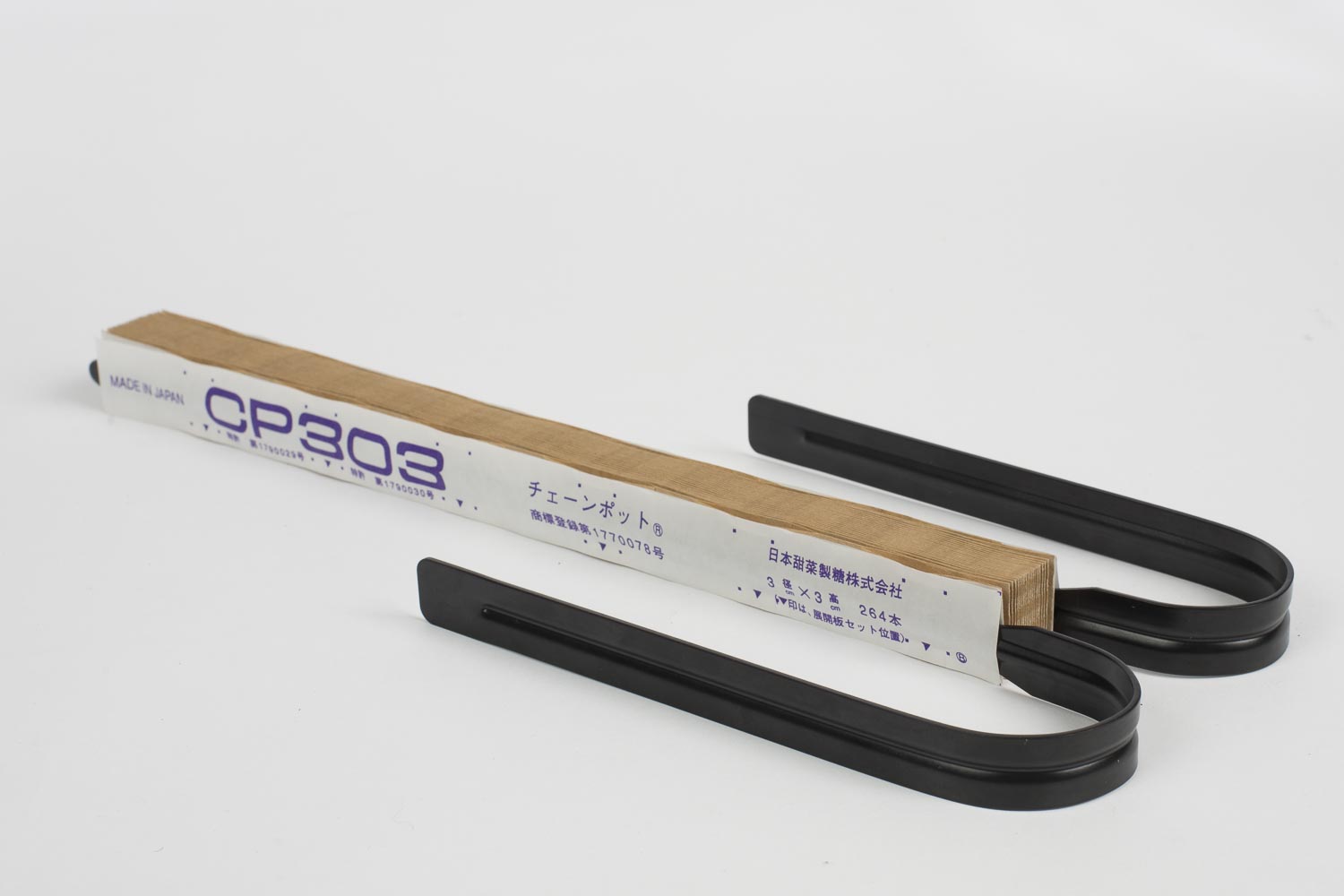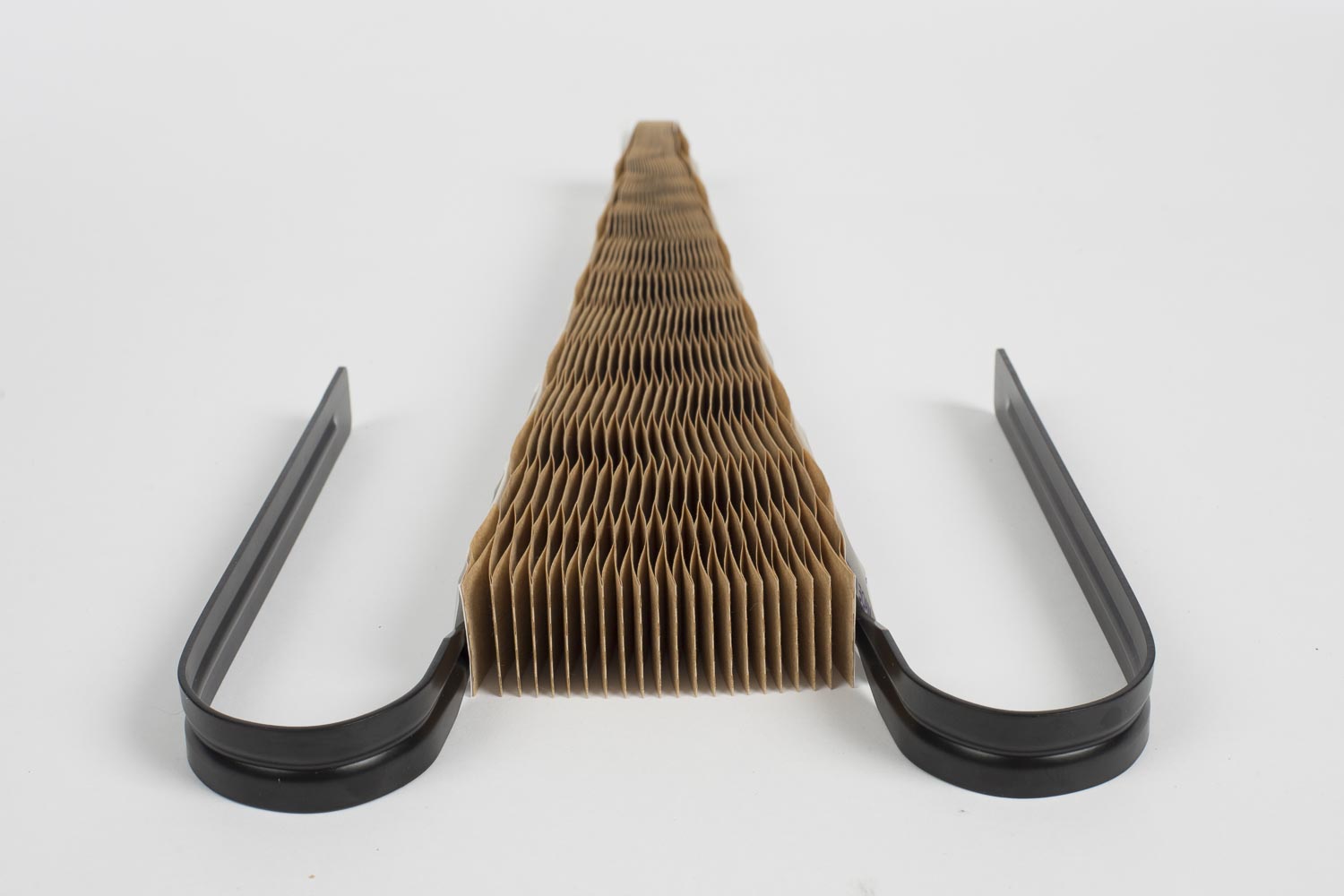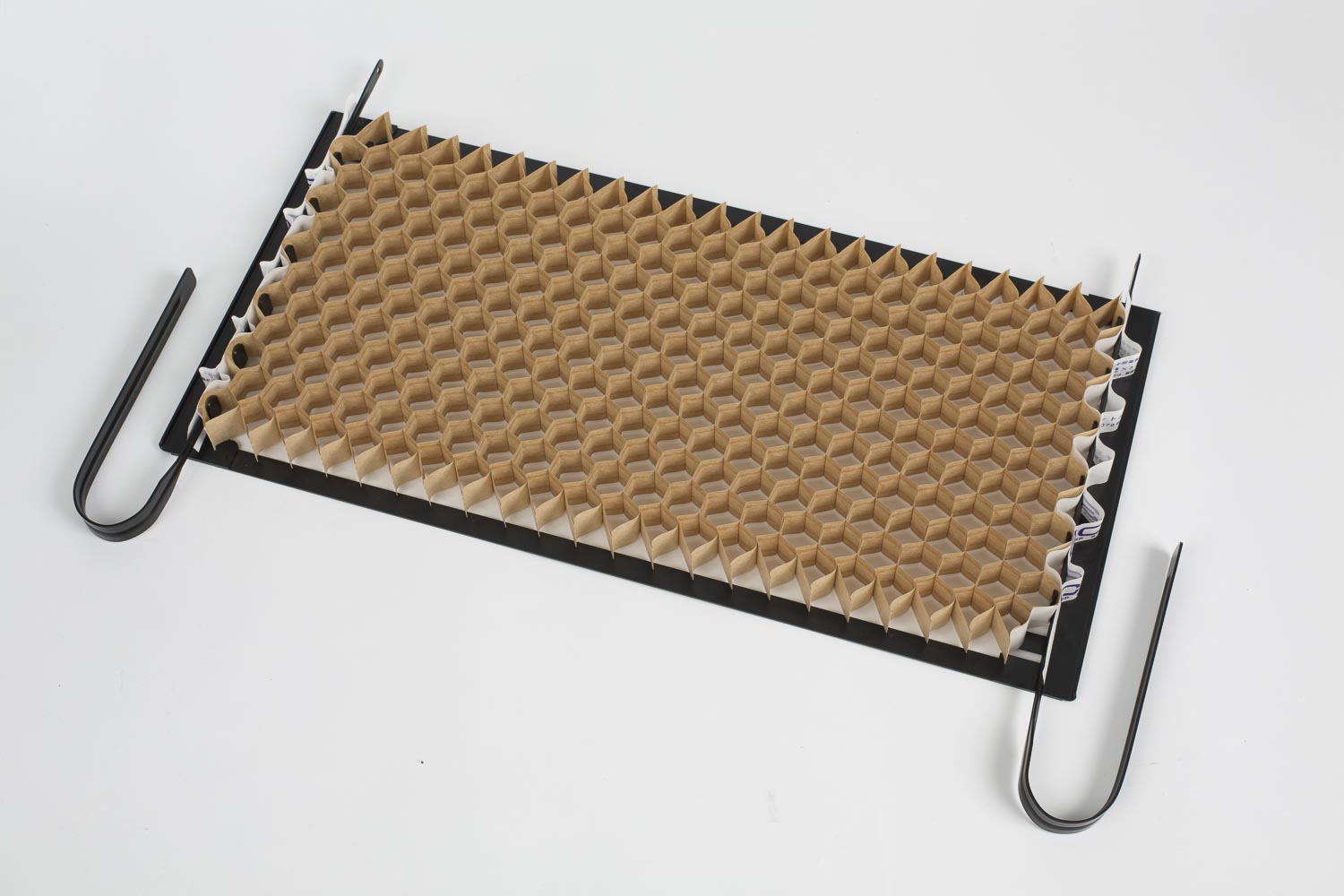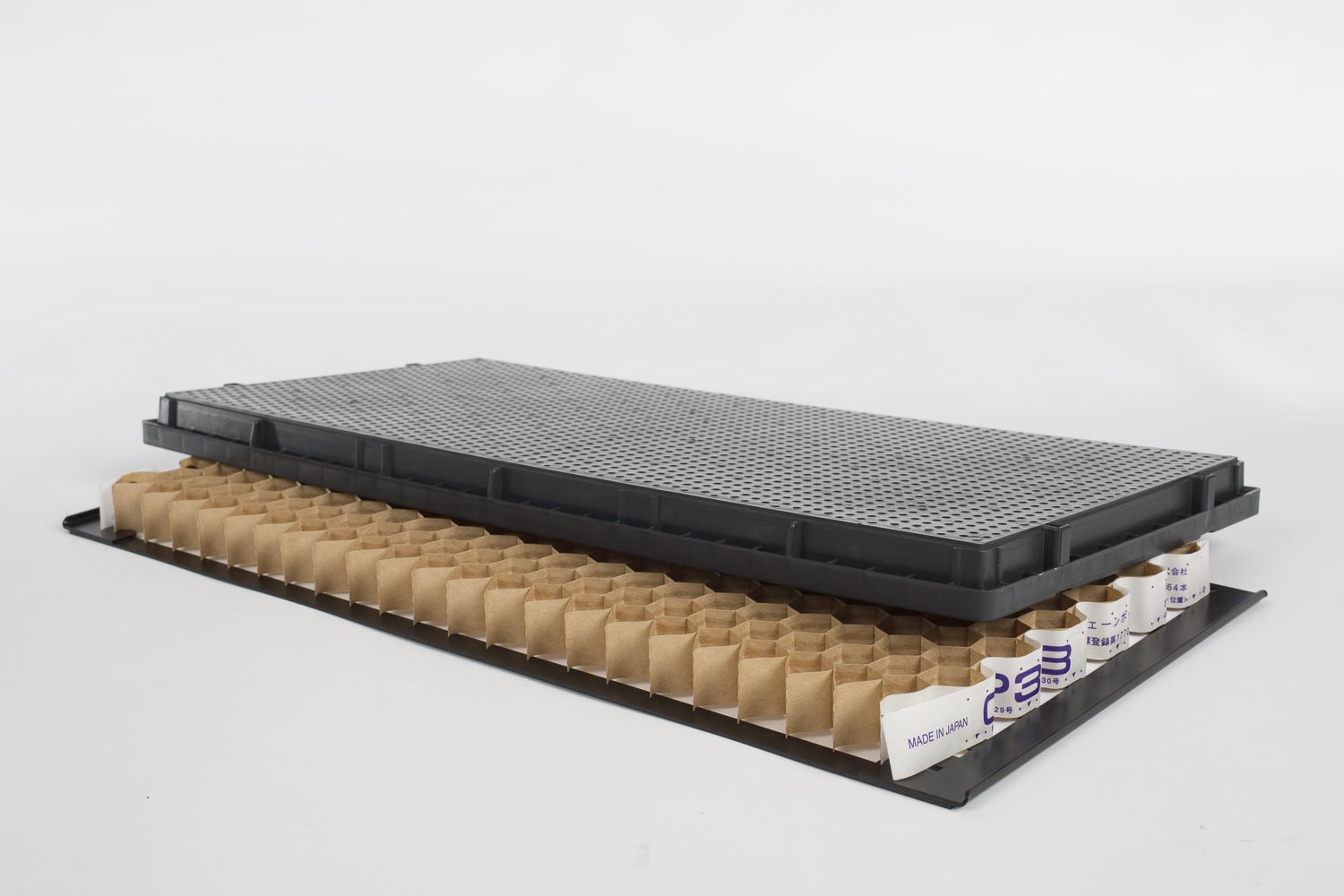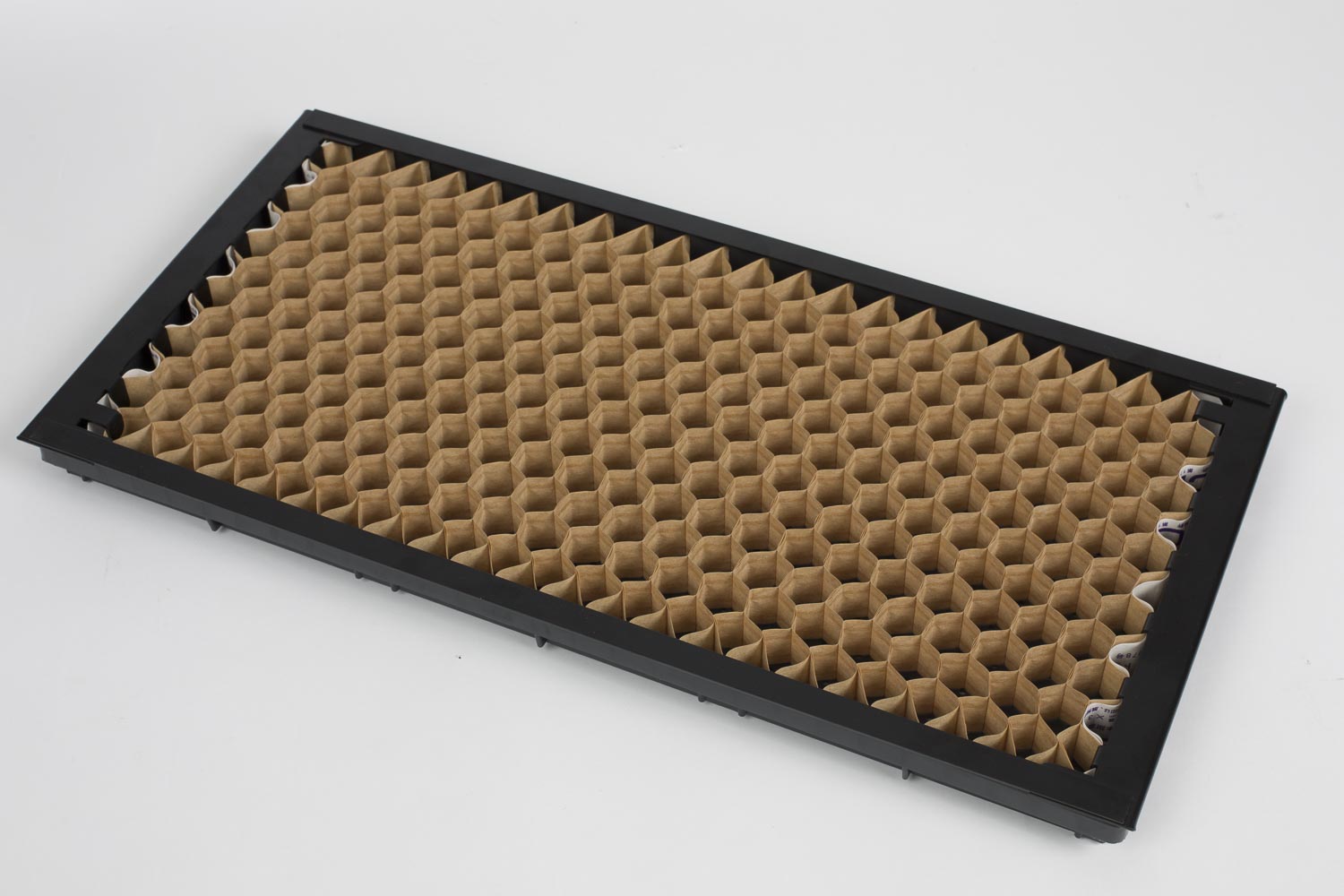Revolutionize your planting work flow
The Paper Chain Pot Transplanting System
The paper chain pot transplanting system is a unique, ingenious, and highly efficient means to transplant vegetables, flowers and herbs. It is unlike any standard transplanter used in the North America or Europe. It has no motor and is pulled by hand. Paper chain pots allow a single person to transplant as many as 264 plants in less than a minute. This is accomplished while standing upright and eliminates countless hours spent kneeling, crawling, or stooping. The best way to understand is to watch the tool in action.
The system relies on seeding into paper pots connected in a chain. Because the pots are chained, they feed themselves through the transplanter automatically. A new flat of paper pots comes compressed and needs to be opened using a set of metal opening rods (see photos). The metal rods are inserted into either side of the compressed paper pots and then pulled apart (not unlike an accordion or paper fan) to reveal a honeycomb of cells. The most common paper pot flats have 264 cells.
The paper pots are then held open by placing the paper pots and metal rods on a metal frame. After placing a plastic bottom tray on the set-up, the cells can be filled with potting soil. Dibble plates are available to make depressions in the potting mix to receive seeds. Seeding a paper pot flats can be done by hand but seeders are available that seed an entire flat at a time. After filling and seeding the flat, the metal opening frame is removed. Watch me demonstrate how to prepare a paper pot flat and use the seeder.
Visit our Store for more information on the various components and options.
Once the seedlings are ready to be transplanted and soil prepared, a transplanter is pulled into the bed to begin creating a furrow. A tray of seedlings is placed on the transplanter platform and one end of the paper pot chain is pulled down into the furrow. A narrow metal stake is inserted through the first cell into the soil to secure the start of the paper chain. Then the transplanter is pulled down the bed and all the seedlings go into the ground, one after the other. Small metal flanges (fingers) at the rear of the transplanter push soil over the paper pots and the transplanter's packing wheels follow, tamping the soil.
Crops, Soil conditions, and Recommendations
The paper pot system is ideally suited to closely-spaced crops. This is because in-row spacing is determined by the length of the paper chain connecting each cell. Currently, paper chain pots are available that result in 2-inch, 4-inch and 6-inch in-row spacing. The system works very well for onions, leeks, scallions, shallots, small lettuce heads, salanova, kohlrabi, baby fennel, spinach, beets, turnips, various Asian greens, cilantro, basil, chard, peas, beans, and many types of cut flowers. Because the paper pot cells are small, it is not suited for crops such as tomatoes and peppers that are typically grown in large cells with ample room to grow a good sized transplant.
You can expand the crops suitable for transplanting with the transplanter by skipping every other cell. Prime crops for this include cabbage, broccoli, kale, larger lettuce heads, fennel, and corn.
The transplanter performs best in a flat, uniform, tilled bed, such as can be created using a walk-behind tiller or tractor-mounted rotovator. In general, better results will be observed in lighter soils than heavy clay soils.
Paper Chain Pot System Requirements
A basic paper pot transplanter setup would include a transplanter, paper pots, opening rods, an opening frame, and growing trays. The growing trays are necessary because the paper pot system is designed to be used with the standard tray used in Japan (the same tray used for growing rice seedlings). The trays are 12 inches wide and 24 inches long, have 4 holes per square inch in the bottom for water drainage, and have a low outer rim (about 1.25 inches). The trays are made of a durable, rigid plastic unlike the flimsy “1020” trays commonly used in the U.S. When calculating the number of trays you need, remember that the standard paper pots flats have 264 cells per flat. Additionally, the three standard paper chain pot types, when planted, are the following lengths:
CP303 2 inch in-row spaced paper pots ~46 feet 14 meters
LP303-10 4 inch in-row spaced paper pots ~89 feet 27 meters
LP303-15 6 inch in-row spaced paper pots ~131 feet 40 meters
Optional, although I cannot imagine being without one, is a dibble board that creates a depression in the potting soil of each cell. Using your fingers to do this gets old quickly with 264 cell flats! Using a dibble board also ensures that each depression is uniform.
The whole flat gravity seeders are remarkably simple and efficient and can be ordered with any size hole to accommodate different sized seeds. They greatly speed up the flat-seeding process but some growers prefer to do this work by hand. These seeders were originally designed in Japan where virtually all commercial vegetable seed is pelleted. So, the system is designed around round, uniform seed. For this reason, these seeders have less functionality in the United State where pelleted seed is not standard for many crops. Most cut flower growers, who deal with very irregular-shaped and sized seeds, find the seeders inappropriate.
Paper Chain Pots
The paper chain pots are available that result in 3 different in-row spacings: 2 inches (5cm), 4 inches (10cm), or 6 inches (15cm). If you want wider spaced seedlings, you can skip cells and thereby double these distances (8 inches or 12 inches). All of these have 264 cells per flat and the cell size is the same, 1.25 inches around and 1.25 inches deep (3cm by 3cm). The extra paper in the chain that creates the longer in-row spacings is wrapped around each cell and the paper "unfurls" as you plant them using the transplanter. Because of the small size of the cells, the paper chain pots system is not well suited to growing things like tomato, pepper, or squash seedlings. For those crops, you can consider using non-chain paper pots.
For more information about the paper chain pots, please see our FAQ page.
Standard Paper Chain Pots have 264 paper cells in a honeycomb pattern. Once spread out, you can fill cells with soil and proceed with planting.


